|
Chachapoyas is about 800 km (straight-line) to the north of
Lima and I had wanted to go there for some time because I had
heard that there was a pre-Inca mountaintop fortress nearby
called Kuelap. It was supposed to be on the same scale as Machu
Picchu and little archaeological study had been made of the site.
Chacha, as it is known, is in the department of Amazonas and
everyone seems to assume that because of this name it would be in
the jungle. In fact about one third of this department is in the
eastern slopes of the Andes highlands with mountains rising up to
4000m and Chacha is at an altitude of 2300m. So, in the second
week of October 1999 I set off to find Kuelap.
(Note; all the images can be viewed in full by
double-left-clicking on the thumbnail image. The first image is
of the main square in Chacha: the remainder are all of Kuelap
fortress.)
In order to avoid a long bus ride through the coastal desert
north up the Panamericana Highway I took a seventy-minute flight
from Lima to Chiclayo where I arrived about lunchtime. After
hanging around this city for the afternoon I caught a direct bus
leaving at 6 p.m. for the eleven hour journey to Chacha. As buses
go I have been on worse; it wasn't particularly clean and, as is
common, didn't have on on-board toilet (if anyone gets caught
short they have to ask the driver to stop and then go and find a
quiet spot by the roadside). However, there was a video on board
and we had two films in English with Spanish sub-titles. There
was a 45-minute stop around 8.30 p.m. at a roadside restaurant
but in Chiclayo I had already bought the local equivalent of
Cornish pasties as a meal for the journey. 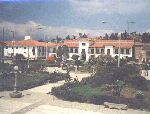 After
the second video the lights were turned out and everyone tried to
sleep as the bus climbed up over passes and down into valleys. I
recall the road changed from asphalt to dirt for about the last
three hours but of course couldn't see anything out of the bus
window. The bus arrived in Chacha at 4.30 a.m. which is no time
to arrive anywhere let alone a small rural town in northern Peru.
However after the bus had parked, anyone who wanted could stay
snoozing on the bus and I was last off at 7 a.m. It was a short
walk to the main square where I found the hotel I wanted and got
the night staff to give me a room. After
the second video the lights were turned out and everyone tried to
sleep as the bus climbed up over passes and down into valleys. I
recall the road changed from asphalt to dirt for about the last
three hours but of course couldn't see anything out of the bus
window. The bus arrived in Chacha at 4.30 a.m. which is no time
to arrive anywhere let alone a small rural town in northern Peru.
However after the bus had parked, anyone who wanted could stay
snoozing on the bus and I was last off at 7 a.m. It was a short
walk to the main square where I found the hotel I wanted and got
the night staff to give me a room.
After a shower and some breakfast I contacted Rob Dover who
is an English guy from Bristol married to a Peruvian girl and who
is a partner in a trekking
and adventure travel business in Chacha. Later we had lunch
together and he told me of the interest shown by major TV
documentary producers in this area; he had just recently returned
from guiding a film crew from Discovery Channel and before that a
UK channel. In the afternoon I arranged with my hotel to take a
bus tour to Kuelap the next day.
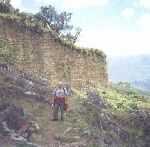 Next morning the bus turned out be to be a
small 12-seater lacking both in leg-room and width, hence I did
not fit too well. Even the Peruvians, who generally are smaller
stature than gringos, have trouble squeezing into these. The bus
left at 8.30 a.m. and within 10 minutes of leaving the town I had
my first experience of local roads; they are narrow, rough, dirt,
and with terrifying drops several hundred metres down the steep
slopes into the river valley below. (I had travelled up this road
in the overnight bus without realising it.) From then on, for the
whole of my time in Chacha, whenever I travelled by road my palms
were sweaty. The route from Chacha took us down to the Rio
Utcubamba, a height loss of 500m, followed the river going
upstream for half an hour then started climbing again and
continued climbing for the next two hours along similar rough,
precipitous roads. We passed through small villages clinging to
the mountainside, over one ridge then into a valley then round
another ridge and so on, climbing continually. Next morning the bus turned out be to be a
small 12-seater lacking both in leg-room and width, hence I did
not fit too well. Even the Peruvians, who generally are smaller
stature than gringos, have trouble squeezing into these. The bus
left at 8.30 a.m. and within 10 minutes of leaving the town I had
my first experience of local roads; they are narrow, rough, dirt,
and with terrifying drops several hundred metres down the steep
slopes into the river valley below. (I had travelled up this road
in the overnight bus without realising it.) From then on, for the
whole of my time in Chacha, whenever I travelled by road my palms
were sweaty. The route from Chacha took us down to the Rio
Utcubamba, a height loss of 500m, followed the river going
upstream for half an hour then started climbing again and
continued climbing for the next two hours along similar rough,
precipitous roads. We passed through small villages clinging to
the mountainside, over one ridge then into a valley then round
another ridge and so on, climbing continually. 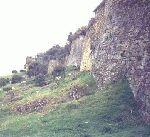 Finally
we arrived at the carpark just below the fortress about mid-day
having gained nearly 1200m from the river. From the car park it
is about a fifteen minute walk uphill to arrive at the outer
walls of the fortress. Gringos have to pay just under US$3
entrance charge to the fortress but for this you get a
Spanish-speaking guide (who expects a tip). Finally
we arrived at the carpark just below the fortress about mid-day
having gained nearly 1200m from the river. From the car park it
is about a fifteen minute walk uphill to arrive at the outer
walls of the fortress. Gringos have to pay just under US$3
entrance charge to the fortress but for this you get a
Spanish-speaking guide (who expects a tip).
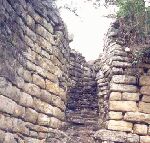 Kuelap fortress is on a mountaintop at an
altitude of 3000m, there are steep cliffs dropping 1200m to the
north and west, a similar but less-steep drop to the east and the
approach from the south is along a ridge about 80m wide. There
are mountains going up to 4000m on the other side of the valleys.
The fortress pre-dates the Incas by several hundred years. It was
built by the Chachapoyas who thought it was impregnable but the
conquering Incas easily found the weak point - it didn't have its
own supplies of food and water - so it fell after a siege. The
Chachapoyas got their own back because when the Spanish
Conquistadors came along about seventy years later they fell in
with them and drove the Incas back out! Kuelap fortress is on a mountaintop at an
altitude of 3000m, there are steep cliffs dropping 1200m to the
north and west, a similar but less-steep drop to the east and the
approach from the south is along a ridge about 80m wide. There
are mountains going up to 4000m on the other side of the valleys.
The fortress pre-dates the Incas by several hundred years. It was
built by the Chachapoyas who thought it was impregnable but the
conquering Incas easily found the weak point - it didn't have its
own supplies of food and water - so it fell after a siege. The
Chachapoyas got their own back because when the Spanish
Conquistadors came along about seventy years later they fell in
with them and drove the Incas back out!
The fortress measures 500m north-to-south and has a total
area of about 6 hectares and it is on three levels. The outer
perimeter wall varies in height from 10 to 15 metres and is
constructed from limestone blocks weighing up to three tons. 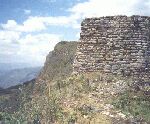 There are three narrow entrances with
steps rising up to the first level. Inside the site there are
ruins of nearly four hundred stone buildings; nearly all are
circular. Most of the buildings have been demolished down to
their foundations; a few remain standing as high as three metres.
The second level is contained within another wall 10m high with
one narrow entrance. On the third level are fewer buildings but
at the north end there is a square tower called Atalaya (used as
a watch tower and as a store; excavations produced 2500 slingshot
missiles). At the south end there is an inverted conical
building called Tintero and its use is the subject of varying
speculation; both human and animal remains have been found there,
but there is also a theory that it had astronomical use. There is
sorrowful-looking human face carved into a cornerstone. It has
been estimated that as much stone went into the construction of
this site as was used to build the Great Pyramid in Egypt. There are three narrow entrances with
steps rising up to the first level. Inside the site there are
ruins of nearly four hundred stone buildings; nearly all are
circular. Most of the buildings have been demolished down to
their foundations; a few remain standing as high as three metres.
The second level is contained within another wall 10m high with
one narrow entrance. On the third level are fewer buildings but
at the north end there is a square tower called Atalaya (used as
a watch tower and as a store; excavations produced 2500 slingshot
missiles). At the south end there is an inverted conical
building called Tintero and its use is the subject of varying
speculation; both human and animal remains have been found there,
but there is also a theory that it had astronomical use. There is
sorrowful-looking human face carved into a cornerstone. It has
been estimated that as much stone went into the construction of
this site as was used to build the Great Pyramid in Egypt.
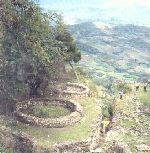 About 90% of the site is
overgrown with trees and bushes (and an abundance of bromeliads)
but the foundations and decorated low walls of the mostly-round
buildings have been cleared away and are easily visible. It is
estimated that the site was occupied between 800 and 1500 A.D. About 90% of the site is
overgrown with trees and bushes (and an abundance of bromeliads)
but the foundations and decorated low walls of the mostly-round
buildings have been cleared away and are easily visible. It is
estimated that the site was occupied between 800 and 1500 A.D. 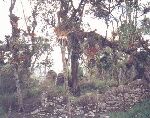 It had both military and
ceremonial use unlike Machu Picchu, which had much greater
significance to the Incas. Many human remains have been found in
the site. A house has been re-constructed to resemble the
original structure as determined by archaeologists, and there was
a dig in progress while we were there. Our guide was very
conscientious and thorough and we spent about one and a
half-hours with him; he earned (and received) his tip. In total
we spent over three hours at Kuelap and set off back around 3.30
p.m. It had both military and
ceremonial use unlike Machu Picchu, which had much greater
significance to the Incas. Many human remains have been found in
the site. A house has been re-constructed to resemble the
original structure as determined by archaeologists, and there was
a dig in progress while we were there. Our guide was very
conscientious and thorough and we spent about one and a
half-hours with him; he earned (and received) his tip. In total
we spent over three hours at Kuelap and set off back around 3.30
p.m. 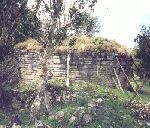 We stopped very briefly for a very late
lunch at a small village and arrived back in Chacha around 7
p.m. We stopped very briefly for a very late
lunch at a small village and arrived back in Chacha around 7
p.m.
Next day every muscle and joint in my body ached from the
hours spent in the bus on rough roads the day before so I spent
the day quietly. I discovered that Chachapoyas is a small, quiet,
rural market town with very friendly people. 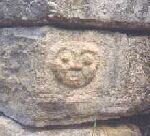 Hardly
anyone speaks English so my Spanish was stretched while I was
there. Very few tourists get to the area and apart from Rob I was
the only gringo in town. By asking around I found out that the
library at the offices of the government health authority had a
PC with Internet access so I was able to fire off a few e-mails
for a small charge. I also found the tourist information office
down a back street and although it didn't have much in the way of
leaflets, the staff were extremely helpful. Hardly
anyone speaks English so my Spanish was stretched while I was
there. Very few tourists get to the area and apart from Rob I was
the only gringo in town. By asking around I found out that the
library at the offices of the government health authority had a
PC with Internet access so I was able to fire off a few e-mails
for a small charge. I also found the tourist information office
down a back street and although it didn't have much in the way of
leaflets, the staff were extremely helpful.
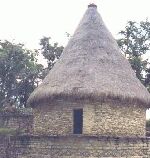 This whole region is the richest archeological
area in Peru and I hoped to see some of the few easily accesible
sites (many are difficult to reach). The following day I wanted
to go to Karajia where some very unusual sarcophagi containing
mummies have been discovered on a ledge on a rockface, but I set
off too late. The first stage in getting there was a local bus to
Luya (another tight squeeze) but I discovered that rural buses
don't run to a timetable; they set off when they are full and I
waited in the bus for 45 minutes. By the time the bus reach Luya
(nearly one and a half hours over more rough terrifying roads) I
realised I wasn't going to have time to get to Karajia so I
continued on to Lamud which was the end of the bus route. Here I
contacted the local director of the National Cultural Institute
and archaeology professor who has a small museum in the
village. This whole region is the richest archeological
area in Peru and I hoped to see some of the few easily accesible
sites (many are difficult to reach). The following day I wanted
to go to Karajia where some very unusual sarcophagi containing
mummies have been discovered on a ledge on a rockface, but I set
off too late. The first stage in getting there was a local bus to
Luya (another tight squeeze) but I discovered that rural buses
don't run to a timetable; they set off when they are full and I
waited in the bus for 45 minutes. By the time the bus reach Luya
(nearly one and a half hours over more rough terrifying roads) I
realised I wasn't going to have time to get to Karajia so I
continued on to Lamud which was the end of the bus route. Here I
contacted the local director of the National Cultural Institute
and archaeology professor who has a small museum in the
village. 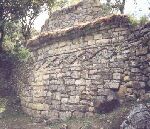 The museum turned out to resemble a junk
store with unlabelled artefacts from different pre-colonial and
colonial periods all lumped together. However the professor was
very enthusiastic and was delighted that someone should come to
see his museum. He also showed me his photo albums of the many
archaeological sites in the region that he had investigated. The
only problem was I understand barely a quarter of what he said;
his local accent was incomprehensible for much of the time; I
have enough trouble understanding Spanish at the best of times.
He refused my offer of a donation to the museum. After some lunch
in the village I caught the next bus back to Chacha. The museum turned out to resemble a junk
store with unlabelled artefacts from different pre-colonial and
colonial periods all lumped together. However the professor was
very enthusiastic and was delighted that someone should come to
see his museum. He also showed me his photo albums of the many
archaeological sites in the region that he had investigated. The
only problem was I understand barely a quarter of what he said;
his local accent was incomprehensible for much of the time; I
have enough trouble understanding Spanish at the best of times.
He refused my offer of a donation to the museum. After some lunch
in the village I caught the next bus back to Chacha.
The following morning I took a short ride by collective taxi
to the village of Huancas - a journey of 20 minutes. The village
is semi-deserted with many abandoned buildings and a lot of the
fields around the village are uncultivated. It is apparent that
much of the population has left due to poverty. A short walk up
to a low ridge behind the town brought me to a spectacular view
down into a very deep river valley with mountains rising in the
distance.
The next day was my return journey to Chiclayo. The bus left
at 3 p.m. and after descending the, by now, familiar road to the
Utcubamba river it continued following the river downstream for
the next two hours. Now I was able to see the road that I had
travelled five days earlier. At times the steep-sided valley
becomes a canyon and the road is actually cut into the rock wall
with an overhanging rock roof. Once it goes through a tunnel in
the rock that is only just big enough to take the bus. Eventually
the valley broadens and this road joins the main asphalt-surface
highway connecting the jungle town of Tarapoto with the coastal
town of Chiclayo, and after another restaurant stop and two more
videos the bus arrived in Chiclayo at 2 a.m.
I stayed one day in Chiclayo and went to the Bruning Museum
in Lambayeque which houses the treasures of Sipan (the gold and
silver artefacts of Sipan match the Tutankamun collection). I had
seen them before when they were in Lima two years ago but it was
worth the trip to see them again. Some of the most important
treasures are on tour so if they come your way it is well worth
going to see them.
A superb book has been published about the Chachapoyas area;
it is called "Warriors of the Clouds : a lost civilization of the
upper Amazon of Peru" written by Keith Muscott and published in
1998 by the University of New Mexico Press. It has excellent
pictures, well-written descriptions and an extensive
bibliography. Look for it in your local library.
Now carry on travelling to -
or go  to the Home page. to the Home page.
|










